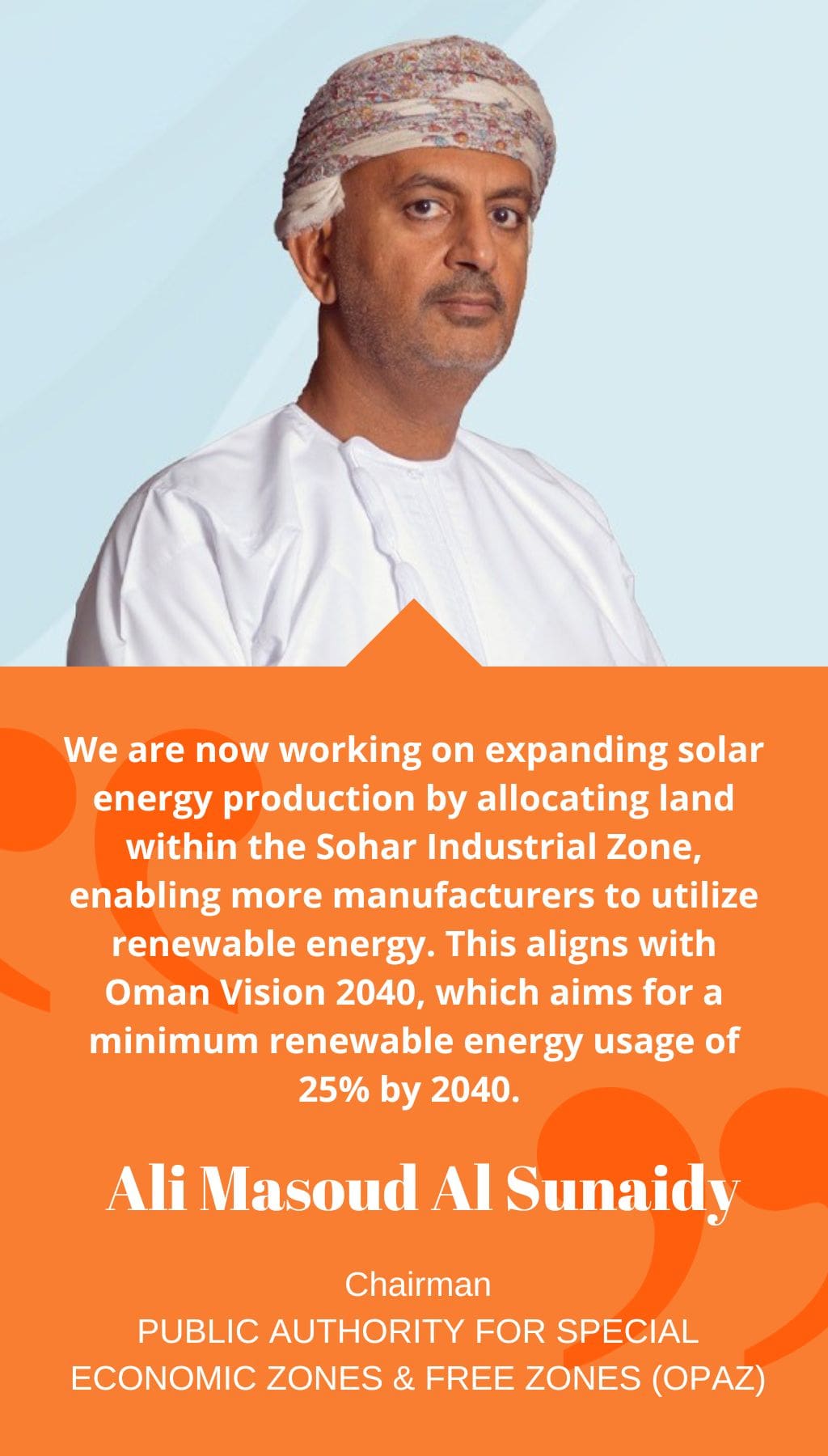
- Oman | 10 May 2021

How do SEZs and free zones contribute to Oman’s energy diversification efforts and reduction of carbon footprint?
SEZs and free zones play a significant role in Oman’s energy diversification and carbon footprint reduction efforts. Sustainability is a key aspect of our planning, and there is a directive from His Majesty Sultan Haitham Bin Tariq for Oman to achieve carbon neutrality by 2050. As part of our efforts, we have been focusing on renewable energy production for the local industry. Sohar Free Zone, for example, has already initiated a 25-MW solar project, becoming the first free zone in Oman to produce renewables. We are now working on expanding solar energy production by allocating land within the Sohar Industrial Zone, enabling more manufacturers to utilize renewable energy. This aligns with Oman Vision 2040, which aims for a minimum renewable energy usage of 25% by 2040. Additionally, energy sustainability is closely tied to water usage. In all our industrial zones, we prioritize the best use of water by utilizing recycled water to create green spaces and minimize the use of desalinated water. For instance, in Duqm, we have plans to plant 5,000 trees and establish three small parks using treated water. Similar initiatives are being implemented in Salalah and other industrial zones. Another aspect of our sustainability efforts is to become completely paperless, and this initiative has already begun at our one-stop shop in Duqm.
How do you assess Oman’s potential to become a global hydrogen exporter, and what is OPAZ doing in this regard?
Oman has significant potential to become a global hydrogen exporter, particularly in the context of the Special Economic Zone at Duqm (SEZAD). We have allocated 250 square kilometers of land within the SEZAD for solar and wind farms, which will produce green hydrogen and green ammonia for local consumption and export. Two licenses have already been granted, with one license in the process of implementing an initial 300 MW plant, and another license undergoing detailed studies for a larger capacity plant. To support this endeavor, we are revisiting the master plan to create corridors throughout the SEZAD that facilitate the transportation of electricity and hydrogen. These corridors will allow the transfer of green hydrogen produced in concession areas around Duqm to the industrial zone and port area for local consumption or conversion into green ammonia for export. The same corridors will also enable the pumping of desalinated water from the beach to the sites of solar and wind farms. Furthermore, we are exploring partnerships to potentially unlock the export of blue hydrogen by creating a corridor from Duqm to retired oil fields, allowing for the capture and reinjection of CO2 back into the oil and gas fields. This also provides future steel manufacturers with CO2 credits. Coordination with other authorities and companies, such as Sohar and Salalah, is also underway, with discussions focused on producing hydrogen for future generation vessels that call at these ports. We collaborate closely with the Ministry of Transport, Communications, and Information Technology and the Ministry of Power and Minerals to ensure the certification of green energy supplied to manufacturers in the various zones.
How does OPAZ stay ahead of the innovation curve and incorporate new technologies into its operations?
OPAZ is committed to staying at the forefront of innovation and embracing new technologies. We have taken significant strides in digitization and have shifted many of our regular meetings and customer services online. Our portal allows for online services, including land allocation, and we are expanding these digital services each year. The COVID-19 pandemic provided an opportunity to accelerate our digital transformation, enabling remote access for staff and the adoption of cloud services. We are increasingly moving toward cloud-enabled services and utilizing cloud infrastructure. This ensures that our operations are agile, efficient, and in line with the latest technological advancements.
How is OPAZ working to develop an encouraging investment environment that promotes the competitiveness of SEZs and free zones?
OPAZ is dedicated to creating an investment environment that fosters competitiveness and attracts investment to SEZs and free zones. We offer various incentives, including long-term tax exemptions, which are clearly stated and advertised. Moreover, all our zones are strategically connected to airports and ports, with a dry port available for Al Mazuna free zone. This connectivity provides easy access to international shipping routes through the Strait of Hormuz, enhancing trade opportunities. Additionally, our zones are connected to the gas network and 400 KV power grids, with great potential for utilizing renewable energy. Over the next five years, we expect to have sufficient green energy to support the main exporting manufacturers, and we are making land available in Duqm, Sohar, and Salalah for this purpose. Our one-stop shop at OPAZ enables fast licensing processes, including recent agreements with the Ministry of Labour for work permits. In fact, OPAZ can issue all construction-related permits, including its own work permits within the free zones, streamlining the investment process and promoting efficiency. We also collaborate closely with the Ministry of Transport, Communications, and Information Technology and the Ministry of Power and Minerals to ensure a coordinated approach between ports, free zones, and the certification of green energy for manufacturers in the various zones.














